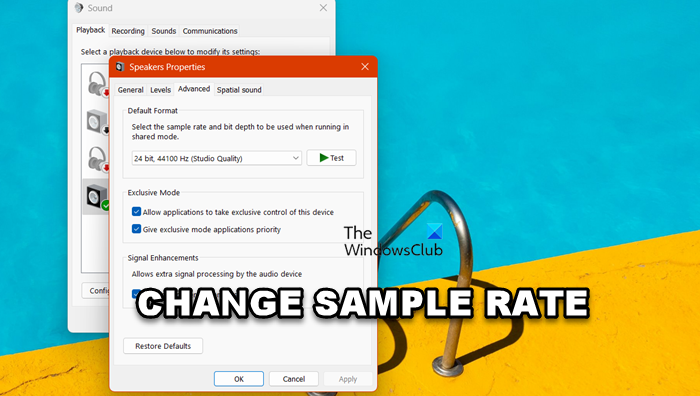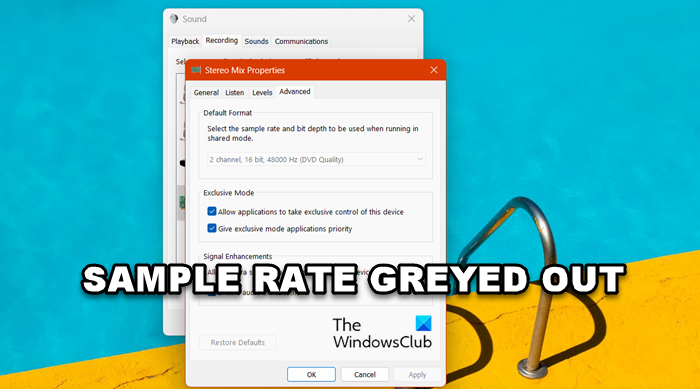Windows gives its users power over the output and input audio of the system. They allow them to change sound settings to improve the computer’s audio. On top of that, they also let users change the Sample Rate. In this post, we will learn what Sample Rate in Windows 11 is and how you can configure it on a Windows computer.
What is Sample Rate in Windows 11?
The Sample is nothing but the frequency of how many times a waveform is measured per second to produce a digital signal that is discreet. In the case of audio, the Sample Rate dictates the range of frequencies captured. If you are a computer nerd, you must have seen 40 kHz as the Sample Rate of your computer. In this, kHz or Killo Heartz is the unit of Audio Sample Rate. Since we humans can hear up to 20 kHz, the computer needs to output 40, which is double the mentioned sample rate. However, these numbers are not meant to make the sound audible; they are there to improve it. That is why we can and should increase the sample rate.
How to change Sample Rate in Windows 11
In this guide, we will show you how to change the Sample Rate as well as the Bit Depth in Windows 11. We will do the following things in this post.
- Change Sample Rate and Bit Depth for Audio Output
- Change Sample Rate and Bit Depth for Audio Input
Let us talk about them in detail.
1] Change Sample Rate and Bit Depth for Audio Output

Let us first change the Sample Rate and Bit Depth for audio output. Remember that with audio output, we mean not only your speakers but also some externally connected devices. Follow the steps mentioned below to do the same.
- Hit Win + S, type “Control Panel” and open it.
- Now, you need to change the View by option to Large icons from the top-right corner of the window.
- Next up, click on the Sound option to launch Sound properties.
- Make sure you are on the Playback tab, right-click on the device on which you want to change the sample rate, and select Properties.
- You then have to navigate to the Advanced tab.
- Now, from the Default format section, you can change the sample rate and bit depth.
- Finally, click Apply > OK.
2] Change the Sample Rate and Bit Depth for Audio Input
Now, let us change the Sample Rate and Bit Depth for your microphone and other audio input devices that are connected to your system. You can follow the steps mentioned below to do the same.
- Navigate to the Sound Properties as mentioned earlier. (steps 1-3)
- Now, navigate to the Recording tab.
- Right-click on your microphone and select Properties.
- Click on the Advanced tab.
- From the Default format section, you can change the sample rate and bit depth.
- Finally, click Apply > OK.
That’s how you can change the sample rate and bit depth of your output and input audio devices.
Read: How to get 24-bit audio on Windows 11?
Why can’t I change the Sample Rate in Windows 11?

If the Sample Rate option is greyed out, check if the manufacturer provides an app to configure audio, as from there, you can change the sample rate and bit depth. In case there is no such app, we can say that the device does not support multiple sample rates.
In my case, the microphone supported a particular sample rate that can not be changed. However, if you know for a fact your device supports multiple sample rates, reinstall its drivers and then see if the issue is resolved. To do the same, you can uninstall your audio driver from the Device Manager and then install a fresh copy of the same from the manufacturer’s website.
Read: Download and Reinstall Realtek HD Audio Manager on Windows 11
How do I change the Sample Rate of Sound in Windows?
To change the sample rate of your device, you need to go to the Sound Properties from the Control Panel. You can then go to the Properties of the device you want to configure and change the Sample Rate and Bit Depth. Check out the aforementioned step-by-step guide to learn how to do the same.